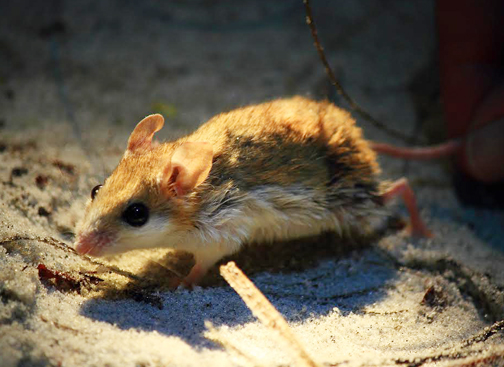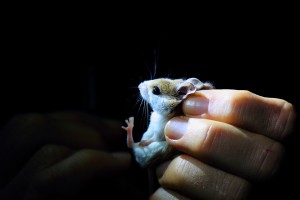
The Choctawhatchee Beach Mouse is one of four Florida Panhandle subspecies classified as endangered or threatened. Beach mice provide important ecological roles promoting the health of our coastal dunes and beaches. Photo provided by Jeff Talbert
Sea Turtles are one of the largest and most beloved animals associated with Florida coastal habitats. However, there is a tiny creature that depends on the coastal dune system that few get a chance to see, the beach mouse. As the name implies, beach mice make their home on beaches and in nearby dunes. These mice are a subspecies of the oldfield mouse. There are eight subspecies, five on the Gulf Coast, two on the Atlantic, and one extinct species.
The Florida Panhandle has four beach mouse subspecies: (in order from East to West) St. Andrew beach mouse, Choctawhatchee beach mouse, Santa Rosa beach mouse, and the Perdido Key beach mouse. Beach mice utilize the primary and secondary dunes for food, water, cover, and raising young. They have many burrows throughout the dunes and forage on seeds, fruits of beach plants, and insects. Beach mice are most active during the night and considered to be nocturnal. Under the cover of darkness, they make several trips in and out of their burrows to find and cache food. Feeding activities of beach mice disperse seeds and plants, adding to the health of the dune ecosystem.
Worldwide, the biggest threat to ecosystem biodiversity is habitat loss and fragmentation. Since beach mice are dependent on one specific type of habitat, it makes them susceptible to natural and human created disturbances. Due to loss of their primary and secondary dune habitats, all the beach mice except for one are classified threatened or endangered. The Santa Rosa beach mouse is the only subspecies that is not listed as threatened or endangered due to most of their habitat being protected within conservation lands on Santa Rosa Island.
Beach mice populations are continually monitored to track movement, growth, and reproduction. The common method for population counts is through the use of traps and track tubes that record mice tracks. Track indices have been developed to estimate mouse abundance.

Choctawhatchee Beach Mouse photographed during research effort in South Walton County. Photo by Jeff Talbert
A collaboration of three state agencies just concluded a five day population study of the Choctawhatchee beach mouse in south Walton County. The purpose of this effort was to study the movement in heavily (beach mice) populated areas and the effects of non-native predators on those populations. Predators specifically studied were feral cats, foxes, and coyotes. The study also evaluated the 2011 re-introduction of 50 beach mice, from the Topsail Hill Preserve State Park population into the Grayton Beach State Park population. Reintroduction was done to boost numbers of the mice in that area and expand the gene pool for the subspecies.
The data from the current effort is still being analyzed but positive results are expected due to healthy beach mice being found in areas of focus and some new areas. Public lands such as parks and wildlife refuges are important for the preservation of beach mice as well as other coastal dune species that utilize similar habitats. It is important that awareness be shared on these and other species to help these efforts to keep our habitats safe and healthy.
For more information on marine science and natural resources information, email or call bsaari@ufl.edu or 850-689-5850.
